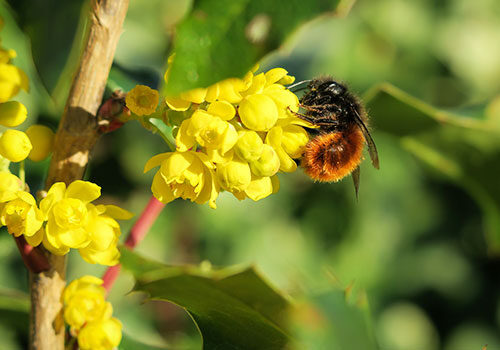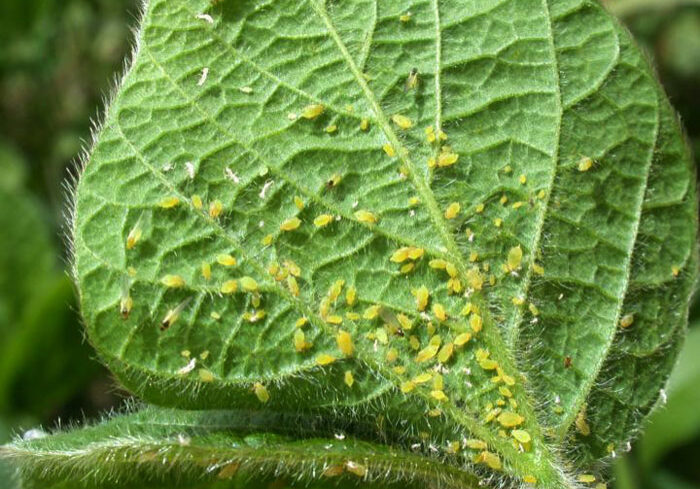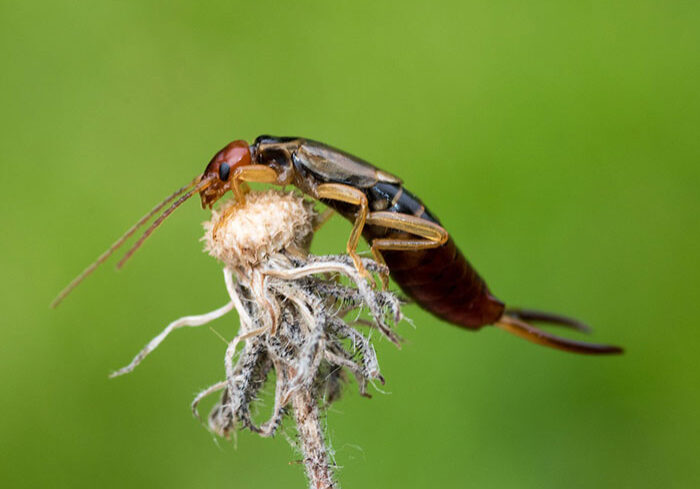POLLINATORS: A GARDENER'S BEST FRIEND
Our native pollinators are in trouble, and gardeners are in a unique position to help.
More and more people are learning about the vital role pollinators play in our ecosystems. As a garden center, we're here to do our part to help, not just with neonicotinoid free flowers and organic products, but with a wealth of tried and true sustainable gardening practices that create a beautiful garden where both pollinators & people can thrive.
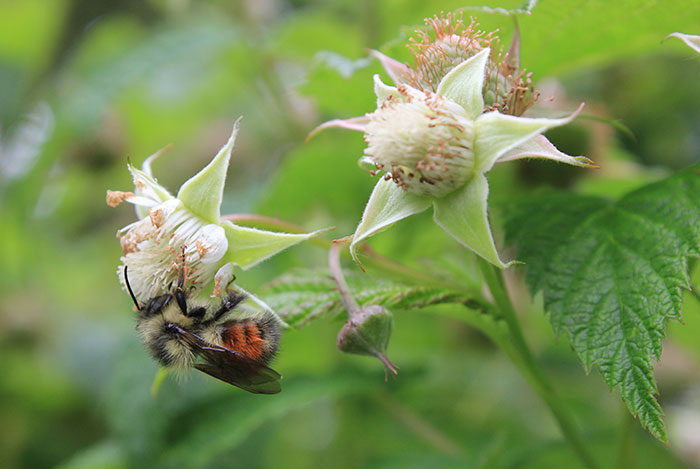
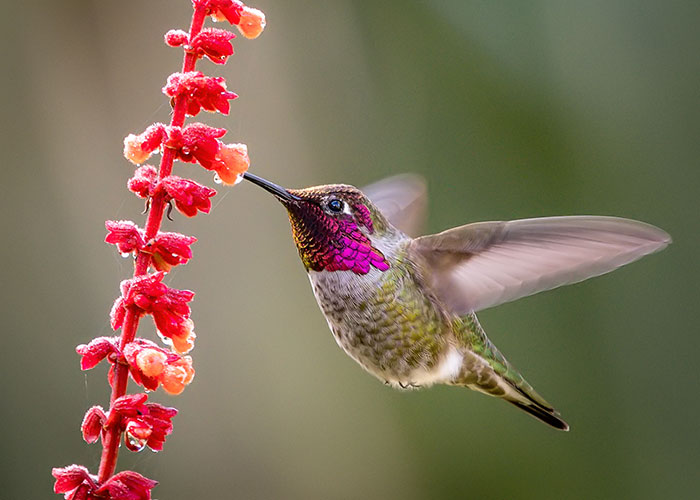
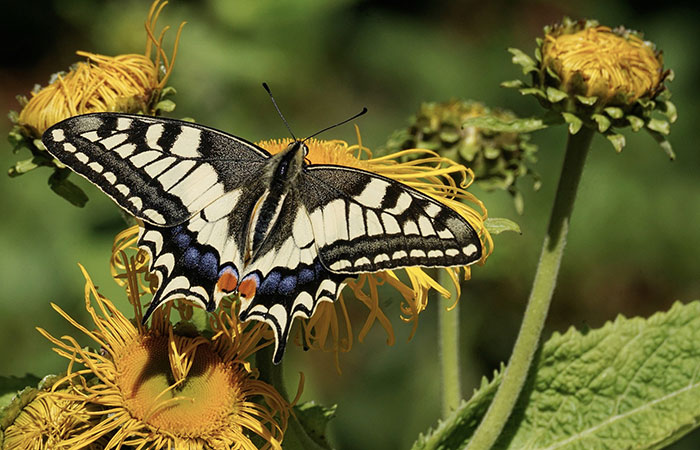
What are Pollinators & Why are They So Important?
Here in the Pacific Northwest,
some of our most important pollinators include native bumblebees & solitary bees, butterflies, moths, flies, & hummingbirds.
Simply put, pollinators are creatures that carry pollen. Almost all plants rely on pollinators to make seeds or fruit. When we talk about helping pollinators, our focus is on the local native insects and birds that the indigenous plants of this region have evolved with for thousands of years.
Many people think of honeybees when they think of pollinators. Honeybees are famous for their handy ability to thrive in human-made hives and for the delicious honey they produce. However, they were introduced to North America from Europe, & they aren’t the pollinators best suited to our wet PNW climate.
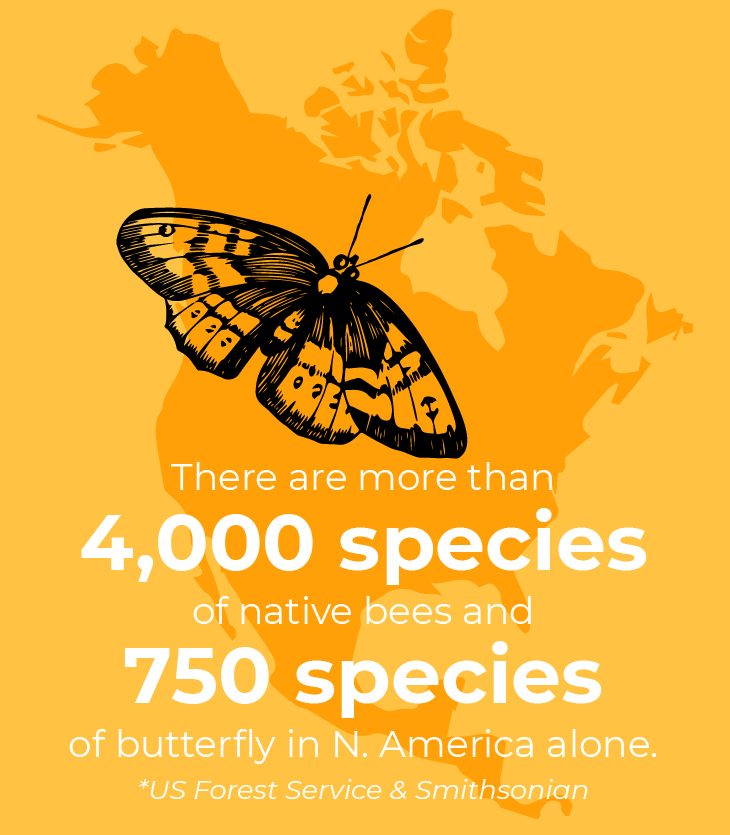
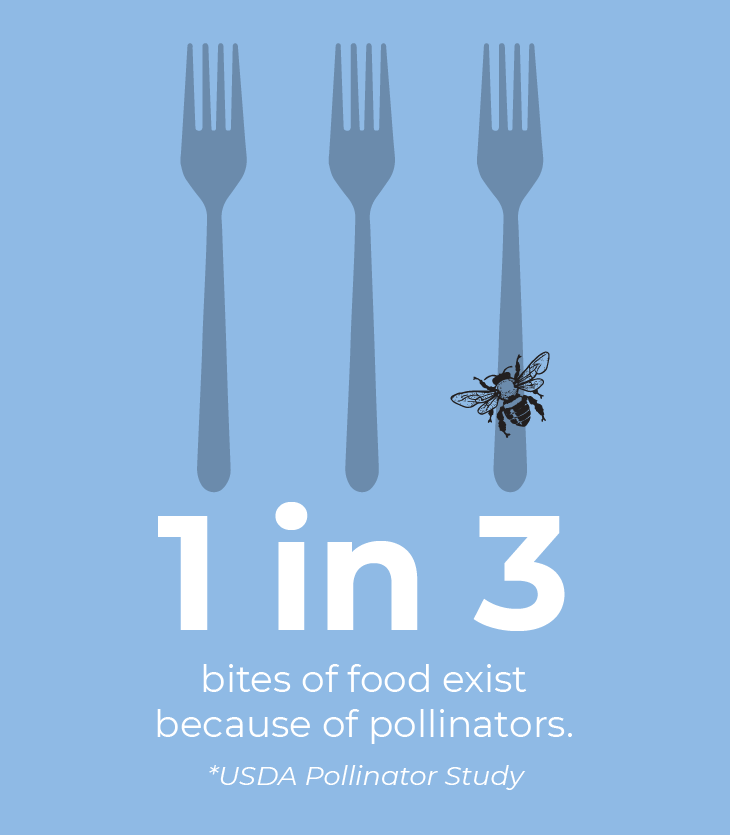
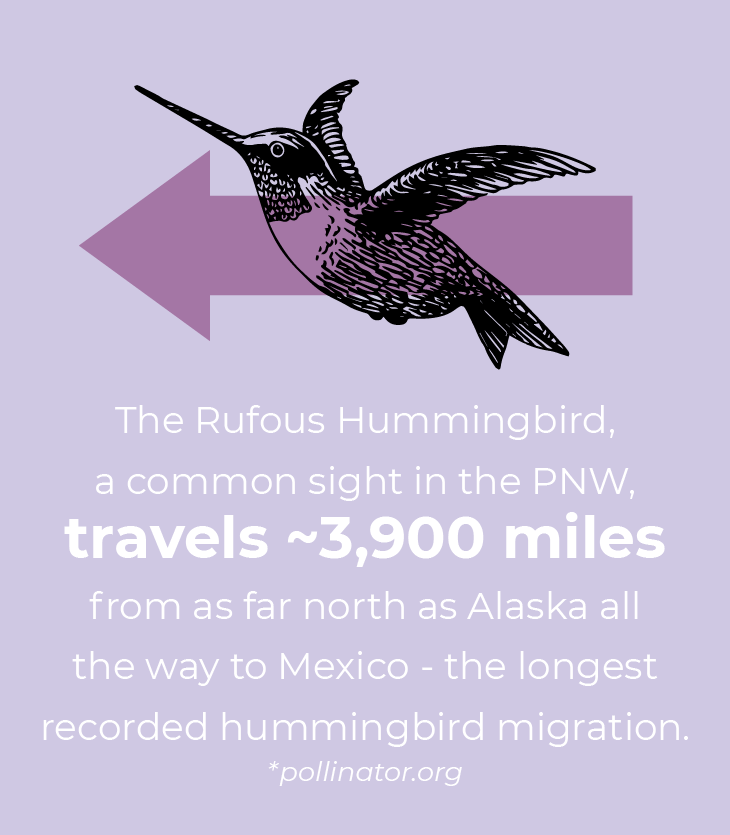
Pollinators are considered 'Keystone Species" because large communities of plants and animals depend on them. If you picture an ecosystem as a complex web of relationships, then keystone species are "hubs" where many strings of the web connect. If you remove a hub, the whole web will be damaged.
As we know, pollinators help many plants produce seeds & fruit, which are eaten by a huge diversity of animals, and in turn many predators eat those animals. So successful pollination isn’t just crucial for plants themselves, but for the whole web of life that depends on them, including humans.
It may be possible, though not easy, to rely on managed honeybee hives or even high-tech interventions for commercial food production. But wild plants and animals still absolutely depend on native bees, birds, etc. to survive. Meanwhile, native pollinators currently provide a lot of help with pollinating human food crops alongside honeybees: a wonderful and free ecological service.
Frequently Asked Questions
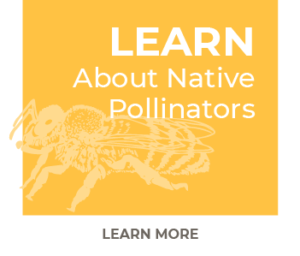
While more and more people have heard that helping the pollinators is important, relatively few people take the time to get to know those pollinators and understand what they need. Our native pollinators have very different needs than honeybees.
For example, did you know that…
- Our vastly diverse native solitary bees can be super tiny or about the size of honeybees, and they come in an amazing range of colors including deep black, iridescent blue, and bright green
- Most bumble bees build their small colonies underground
- Native butterfly and moth caterpillars often overwinter in piles of leaves
- Many solitary bees lay their eggs inside hollow plant stems to overwinter and emerge in the spring
- Solitary bees don’t sting at all, and bumble bees only sting in dire situations to protect their nests
- Wasps and hornets can be pollinators too, and they eat pests!
Once we start getting to know our native pollinators, we can better meet their needs. How many species of native pollinators can you learn to identify in your own garden? Here are a few resources to get you started:
- A great overview for getting to know Northwest Native bees from the Arboretum Foundation
- More information on WA bumble bees from Washington State University
- A podcast on solitary bees from Oregon State University
- A field guide to a variety of native bees from the Oregon State Department of Agriculture
- A gallery of some butterflies and moths that are native to Washington State
- Read more about Pollinators on our Blog.
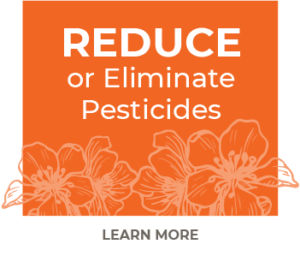
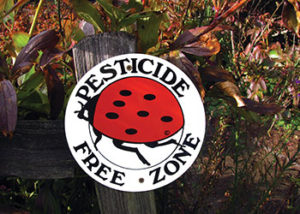 One of the best things gardeners can do to help pollinators is to create safe, non-toxic environments where they can thrive. Insecticides are designed to kill insects, and they don’t discriminate between pests and garden friends.
One of the best things gardeners can do to help pollinators is to create safe, non-toxic environments where they can thrive. Insecticides are designed to kill insects, and they don’t discriminate between pests and garden friends.
It’s best to rely on holistic practices that keep your whole garden ecosystem healthy and balanced. Choosing the right place for the right plant, good fertilizing practices, and creating habitat for predatory insects can go a long way towards reducing major pest outbreaks. Gardeners can also learn to tolerate a few pests here and there as part of the natural cycles of their gardens.
It’s worth noting that there are degrees of toxicity and particularly risk to pollinators when it comes to pesticides. If you do find yourself with a major infestation on your hands, we can help you find the least toxic options.
When it comes to spraying anything, be it an organic pesticide, or even a fungicide or herbicide, the only way to ensure that it will not harm our beneficial pollinators is to spray when you can be certain they are not active. i.e before the flowers bloom, or if you must, after sunset, to minimize damage.
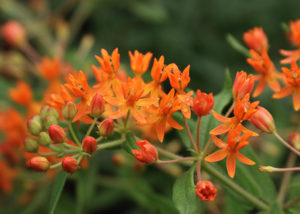
Asclepias tuberosa
Native pollinating insects need food from very early spring through late fall. Anna’s hummingbirds are awake and foraging all year long! Incorporate diverse plants that flower at different times to provide nectar all season. Our perennials by bloom time information sheet can help you design an ever-blooming garden for your own enjoyment and to feed pollinators, especially in combination with the pollinator plant list below.
Most native pollinators can use nectar and pollen from pretty much any flower. But they especially thrive when they have access to the native plants they have always relied on. Again, consider choosing options with a variety of bloom times. Check out The Audubon Society’s native plant finder for some ideas that might be a good fit for your garden.
If you want to plant flowers for pollinators, be sure to avoid 'double-flowering' varieties that may not have nectar/pollen for them to collect.
Butterflies and moths need leaves their caterpillar larvae can eat. Yes, this means accepting a few holes in your leaves! Our pollinator list below has examples of both nectar plants and larvae host plants that you can include in your yard.
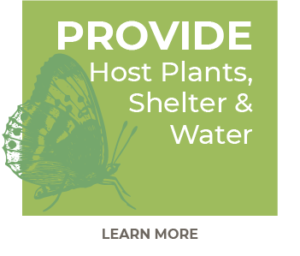
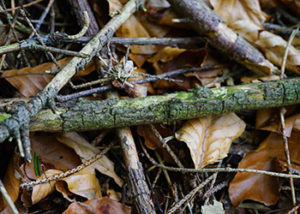 While we might think of flowers first, pollinators’ needs go beyond just nectar and pollen. If you want to take care of your pollinators more holistically, here are some other things you can provide:
While we might think of flowers first, pollinators’ needs go beyond just nectar and pollen. If you want to take care of your pollinators more holistically, here are some other things you can provide:
- We all need water to drink, especially through the dry summer months. A shallow dish of water with pebbles for your bug friends to stand on can help a lot.
- Bumblebees and some solitary bees need loose, shaded, undisturbed soil for underground habitat. Reserving a section of your garden for native shrubs and letting it go a little wild is a great way to provide nest sites.
- Restrain your fall clean-up impulses as much as you can, or at least reserve some spaces that are allowed to stay untidy as overwintering habitat. In the fall, there are very likely butterfly caterpillars and moth cocoons in your fallen leaves, queen bumblebees in your brush piles who are already harboring next season’s fertilized eggs, and solitary bee eggs waiting out the winter inside those dried-up flower stems.
Providing for pollinators within your own garden is a lovely thing to do, but we’ll need to work together to address the big challenges they face. Gardeners can reach beyond their individual gardens by getting involved with advocacy organizations like The Xerces Society that are already working for large-scale change.
Another way you can expand your passion for pollinators beyond your own garden is to reach out to those around you. Whether that looks like posting on social media, putting up 'Pesticide Free' or 'Pollinator Zone' signs around your garden for the neighbors to see, volunteering with organizations doing education work, or being that person who won’t stop gushing about pollinators at family gatherings, there are lots of ways to get the word out. (Dressing your dog up as a pollinator and then asking people if they'd like to learn more is also great.)
On the Blog
Bee Or Not a Bee? A Guide to Flying Garden Friends
Gardeners know how important bees are to our gardens and our planet, and most of us welcome the ones we recognize. But for all their popularity, bees remain misunderstood.…
Read MorePest Prevention: Stop Problems Before They Start
For natural pest prevention, early spring is the time to start!
Read MorePests With Benefits: Give these critters a second chance
Just like many garden flora have a reputation as “weeds,” certain fauna are often labeled as “garden pests.” Some are vehemently accused of damaging our plants or wreaking havoc in…
Read MorePlants for Pollinators
The choices below are especially tasty to pollinators but in reality, almost any flowering plant can attract them. You might be surprised what gets them all a-buzz! For great in-person ideas, visit our Nectar Bar of plants for pollinators in the greenhouse during June & July, or grab a printout and explore the nursery year-round!
| Acer | Maple | Butterfly | Deciduous tree | Foliage plants - No blooms | Caterpillar host plant |
| Achillea | Yarrow | Bee, Butterfly | Perennial flower | Late Spring to Early Summer - May & June | Long blooming, native variety available, aromatic and herbal |
| Agastache asstd. | Anise Hyssop | Bee, Hummingbird | Perennial flower | Late Summer to Early Autumn - Late August & September | Full sun, tolerates tough conditions; reblooms if cut back hard, purple flowers |
| Alcea rosea | Hollyhock | Hummingbird | Perennial flower | High Summer - June, July, & August | Tall, long-blooming cottage garden flower in pink, white, red and purples |
| Amelanchier alnifolia | Serviceberry | Butterfly, Hummingbird | Deciduous shrub | High Spring - End of March, April, & Early May | Butterfly host plant, Fruits loved by birds & small mammals |
| Angelica gigas | Angelica | Bee | Deciduous herb | High Summer - June, July, & August | Architectural foliage/flowers reach 5’, moist soil, some shade |
| Antirrhinum | Snapdragon | Hummingbird | Annual flower | High Spring - End of March, April, & Early May | Cold tolerant, blooms both spring & fall in variety of colors |
| Aquilegia | Columbine | Hummingbird | Perennial flower | High Spring - End of March, April, & Early May | Red-flowered varieties are best; native species available |
| Arbutus unedo | Strawberry Tree | Hummingbird | Evergreen shrub/tree | Autumn to Early Winter - September, October, November & December | Related to native madrone; white flowers & red fruit at same time |
| Arctostaphylos | Manzanita | Butterfly, Hummingbird | Evergreen shrub | Late Winter - January & February | Long blooming, bell shaped pink/ white flowers, caterpillar host plant |
| Arctostaphylos uva-ursi | Kinnikinnick/Bearberry | Bee, Butterfly, Hummingbird | Native groundcover | Late Spring to Early Summer - May & June | Fragrant bell-shaped flowers, then red berries, evergreen leaves |
| Armeria | Thrift, Sea Pink | Butterfly | Perennial flower | High Spring - End of March, April, & Early May | Full sun, container plant, slow spread, Look for native Armeria maritima |
| Asclepias asstd. | Butterfly Weed | Bee, Butterfly, Hummingbird | Perennial flower | High Summer - June, July, & August | Abundant nectar; Caterpillar host plant (monarch fav. but rare in PNW) |
| Aster asstd. | Aster | Bee, Butterfly | Perennial flower | Late Summer to Early Autumn - Late August & September | Choose single-flowered varieties for bees, light, dark pink & purple flowers |
| Aurinia saxatilis | Basket of Gold | Butterfly | Evergreen groundcover | Late Winter to Early Spring - Late Feb & March | Mounding plant with bright yellow flower clusters, seaside tolerant |
| Begonia | Begonia | Hummingbird | Annual flower | High Summer - June, July, & August | Shade loving; upright, trailing waxleaf varieties all available |
| Berberis asstd. | Barberry | Bee | Deciduous shrub | Late Winter to Early Spring - Late Feb & March | Very tough, easy to grow, drought tolerant with red berries in fall |
| Borago officinalis | Borage | Bee, Butterfly | Annual flower | High Spring - End of March, April, & Early May | Bee’s favorite food. Easy to grow, edible blue flowers. Will self-sow. |
| Buddleia | Butterfly Bush | Bee, Butterfly, Hummingbird | Deciduous shrub | Late Summer to Early Autumn - Late August & September | Sky sells non-invasive varieties, honey-like fragrance, purple flowers |
| Calendula | Calendula | Bee, Butterfly | Annual flower | High Spring - End of March, April, & Early May | Can re-seed, thrives in cooler weather, blooms spring & fall |
| Calocedrus | Incense Cedar | Butterfly | Evergreen tree | Foliage plants - No blooms | Caterpillar host plant |
| Camellia sasanqua | Camellia | Hummingbird | Evergreen shrub | Autumn to Early Winter - September, October, November & December | Fall-blooming Many colors; some fragrant |
| Campanula sp. | Campanula sp. Bellflower | Butterfly, Hummingbird | Perennial flower | High Summer - June, July, & August | Full sun, part shade, beautiful periwinkle bell-shaped blooms |
| Campsis | Trumpet Vine | Hummingbird | Perennial vine | High Summer - June, July, & August | Vigorous growth habit; tubular orange or red flowers |
| Caryopteris | Bluebeard | Bee, Butterfly, Hummingbird | Deciduous shrub | Late Summer to Early Autumn - Late August & September | Full sun, long blooming blue/purple flowers, aromatic leaves |
| Ceanothus | California lilac | Butterfly, Hummingbird | Evergreen native shrub | Late Spring to Early Summer - May & June | Drought tolerant, blue/violet flowers, caterpillar host plant |
| Chaenomeles | Flowering Quince | Hummingbird | Deciduous shrub | Late Winter to Early Spring - Late Feb & March | Brightly colored flowers before the foliage emerges |
| Chrysanthemum | Daisy | Butterfly | Perennial flower | Late Summer to Early Autumn - Late August & September | Wide variety in species, bees may use pyrethrum to ward off mites |
| Cirsium | Thistle | Bee, Butterfly | PNW Native | Late Summer to Early Autumn - Late August & September | Full sun, caterpillar host plant, deer/rabbit resistant, dry & rocky soil |
| Clarkia | Clarkia | Butterfly | NW Native wildflower | High Summer - June, July, & August | Full sun, part shade, pink/red flowers, available as seeds at Sky |
| Clematis armandii | Evergreen Clematis | Hummingbird | Evergreen vine | Late Winter to Early Spring - Late Feb & March | Fragrant white to light pink flowers, beautiful foliage |
| Clematis asstd. | Clematis | Hummingbird | Deciduous vine | Late Spring to Early Summer - May & June | Dwarf to large; rainbow of colors available; many will rebloom |
| Cleome asstd. | Spider Flower | Bee, Hummingbird | Annual flower | High Summer - June, July, & August | Purple & pink flowers, 4-6’ tall; foliage has unique herbaceous aroma |
| Coreopsis grandiflora | Coreopsis | Bee, Butterfly | Perennial flower | High Summer - June, July, & August | Long blooming, golden yellow flowers, drought-tolerant |
| Coriander sativum | Coriander/Cilantro | Bee | Annual herb | High Summer - June, July, & August | Self-sowing, allow plants to flower (bolt) for pollinators, white flowers |
| Cornus | Dogwood | Butterfly, Hummingbird | Deciduous tree | Late Spring to Early Summer - May & June | Many white or pink flowers; good fall color, caterpillar host plant |
| Corylus sp. | Hazelnut, Filbert | Bee | Deciduous native tree | Late Winter - January & February | Edible nuts, ornamental varieties available; takes partial shade |
| Cosmos | Cosmo | Bee, Butterfly | Annual flower | High Summer - June, July, & August | Long-blooming, easy to grow, makes a great meadow plant! |
| Crataegus asstd. | Hawthorne | Bee, Hummingbird | Deciduous tree | Late Winter to Early Spring - Late Feb & March | Lovely, multi trunked,urban gardens |
| Crocosmia | Coppertips | Hummingbird | Perennial flower | High Summer - June, July, & August | Naturalizing bulb, tall spikes of bright red, orange, yellow flowers |
| Crocus | Crocus | Bee | Bulb | Late Winter - January & February | Great early bloomer; can naturalize; good in containers |
| Cyclamen, hardy | Cyclamen | Bee | Bulb | Late Winter - January & February | Naturalizing bulb, unique pink/red/white flowers, takes light shade |
| Cynara cardunculus | Cardoon | Bee | Deciduous perennial | High Summer - June, July, & August | Silvery foliage, artichoke-like flower, 5’ tall edible. Full sun & reg. water |
| Dahlia | Dahlia | Hummingbird | Perennial flower | Late Summer to Early Autumn - Late August & September | Full sun, dwarf to dinnerplate sizes, great late summer show |
| Delphinium | Larkspur | Hummingbird | Perennial flower | Late Spring to Early Summer - May & June | Spikes of blue, pink, purple, or white fairy flowers |
| Dianthus barbatus | Sweet William | Bee, Butterfly | Biennial flower | Late Spring to Early Summer - May & June | Short-lived but, can re-seed, tolerates light shade, white, pink, red flowers |
| Dicentra formosa | Bleeding Heart | Butterfly, Hummingbird | Perennial flower | High Spring - End of March, April, & Early May | Lovely spring ephemeral flower, Caterpillar host plant |
| Digitalis | Foxglove | Hummingbird | Perennial flower | High Summer - June, July, & August | Tall spires of tubular pink, fuchsia, white and peach fairy flowers |
| Echinacea purpurea | Coneflower | Bee, Butterfly | Perennial flower | Late Summer to Early Autumn - Late August & September | Full sun, red, orange, yellow, pink blooms, seeds attract birds |
| Echinops asstd. | Globe Thistle | Bee, Butterfly | Perennial | Late Summer to Early Autumn - Late August & September | Metallic blue flowers, gray green foliage, very cool looking plant |
| Epilobium | Fireweed | Butterfly | Native wildflower | High Summer - June, July, & August | Long blooming, 8 ft, fast growing, caterpillar host plant |
| Erica carnea | Winter Heather | Hummingbird | Evergreen shrub | Late Winter - January & February | Compact sub - shrub grown for foliage interest as well as flowers |
| Eryngium asstd. | Blue Sea Holly | Bee, Butterfly | Perennial | Late Summer to Early Autumn - Late August & September | Unusual metallic blue flowers, attracts beautiful native wasp sp. |
| Fuchsia | Fuchsia | Bee, Butterfly, Hummingbird | Annual & Perennial | Late Spring to Early Summer - May & June | Hanging baskets will be hummer magnets all summer |
| Fuchsia, hardy | Fuchsia | Bee, Butterfly, Hummingbird | Perennial flower | Late Summer to Early Autumn - Late August & September | Upright, hardy relative of hanging annual fuchsia, delicate flowers |
| Gaillardia | Blanket Flower | Butterfly | Perennial flower | Late Spring to Early Summer - May & June | Full sun, can self-seed with some hybridized variations |
| Gaultheria shallon | Salal | Bee, Butterfly, Hummingbird | Native groundcover | High Spring - End of March, April, & Early May | Edible fruit July-September, slow growing, white bell-shaped flowers |
| Gladiolus | Gladiola | Hummingbird | Perennial flower | High Summer - June, July, & August | Bulb producing dwarf or tall spikes of flowers, rainbow of colors |
| Grevillea | Grevillea | Hummingbird | Evergreen shrub | Autumn to Early Winter - September, October, November & December | Drought tolerant; orange-red flowers fall through spring |
| Hamamelis | Witch Hazel | Hummingbird | Deciduous shrub | Late Winter - January & February | Spidery yellow, orange, or red blooms, great fall color |
| Helianthus ‘Lemon Queen’ | Lemon Queen Sunflower | Bee, Butterfly | Perennial flower | Late Summer to Early Autumn - Late August & September | Tall sunflower w/ many small lemon yellow flowers in early fall |
| Helianthus annuus | Sunflower | Bee, Butterfly | Annual flower | Late Summer to Early Autumn - Late August & September | Full sun, avoid non-allergenic varieties, caterpillar host plant |
| Heuchera | Coral Bells | Bee, Hummingbird | Perennial flower | High Summer - June, July, & August | Year-round evergreen foliage, bell shaped pink/white blooms |
| Hibiscus syriacus | Rose of Sharon | Hummingbird | Deciduous shrub | Late Summer to Early Autumn - Late August & September | Full sun, white, pink, red, purple, lavender tropical blooms |
| Iberis | Candytuft | Butterfly | Perennial flower | High Spring - End of March, April, & Early May | Full sun, some re-blooming varieties, good in rock gardens/sandy soil |
| Kniphofia | Red Hot Poker Plant | Hummingbird | Perennial flower | High Summer - June, July, & August | Spectacular firework blooms of red shading to yellow, long blooming |
| Lantana | Lantana | Butterfly, Hummingbird | Annual flower | High Summer - June, July, & August | Long blooming, full sun, lots of color varieties, avoid foliage sap |
| Lavandula asstd. | Lavender | Bee, Butterfly | Evergreen perennial | High Summer - June, July, & August | Well draining soil, do not fertilize, bees especially love Spanish varieties |
| Liatris | Gayfeather/Blazing Star | Bee, Butterfly, Hummingbird | Perennial flower | Late Summer to Early Autumn - Late August & September | Full sun, North American native plant with tall purple flower spikes |
| Linarea purpurea | Toadflax | Bee | Perennial flower | Late Summer to Early Autumn - Late August & September | Dry Mediterranean plant, 3’, violet/pink flowers, self sows |
| Lobelia cardinalis | Cardinal Flower | Hummingbird | Perennial flower | High Summer - June, July, & August | Moisture-loving with flame-red blooms on tall flower spikes |
| Lonicera | Honeysuckle | Butterfly, Hummingbird | Vine/shrub | High Summer - June, July, & August | Evergreen/Deciduous available; many fragrant; tubular flowers |
| Lupinus | Lupine | Bee, Butterfly, Hummingbird | Perennial flower | Late Spring to Early Summer - May & June | Full sun, can self-seed, deer resistant, caterpillar host plant |
| Mahonia | Oregon Grape | Butterfly, Hummingbird | Evergreen Native shrub | Late Winter - January & February | Shade, yellow blooms, summer blue berries for songbirds |
| Malus | Apple, Crabapple | Butterfly, Hummingbird | Deciduous fruit tree | High Spring - End of March, April, & Early May | White/pink flowers, good fall color; caterpillar host plant |
| Melissa officinalis | Lemon Balm | Bee | Deciduous herb | High Summer - June, July, & August | Long blooming, easy to grow, self-seeding, small white/purple blooms |
| Mentha piperita | Peppermint | Bee, Butterfly | Deciduous herb | High Summer - June, July, & August | Best mint for pollen, allow plants to flower for pollinator benefit! |
| Mimulus | Monkeyflower | Bee, Butterfly | Perennial flower | Late Summer to Early Autumn - Late August & September | Long blooming, full sun, moist soil, caterpillar host plant |
| Monarda | Bee Balm | Bee, Butterfly, Hummingbird | Perennial flower | High Summer - June, July, & August | Long blooming, choose mildew resistant varieties |
| Nepeta asstd. | Catmint (Not Catnip) | Bee, Butterfly | Deciduous perennial | High Summer - June, July, & August | Long blooming, easy to grow, full sun, great filler plant |
| Oreganum officinalis | Oregano | Bee, Butterfly | Deciduous herb | Late Winter to Early Spring - Late Feb & March | Both culinary & ornamental varieties. Self sows nicely |
| Oxalis oregano | Redwood Sorrel | Bee | PNW Native groundcover | Late Winter to Early Spring - Late Feb & March | Shade, can tolerate wet & dry soil conditions, white blooms |
| Papaver somniferum | Breadseed Poppy | Bee | Annual flower | Late Spring to Early Summer - May & June | Re-seeding pink, purple, red & white flowers, attractive seed pods |
| Penstemon | Beard Tongue | Butterfly, Hummingbird | Perennial flower | High Summer - June, July, & August | Full sun, attractive tubular flowers in a rainbow of colors |
| Perovskia atriplicifolia | Russian Sage | Bee | Perennial flower | High Summer - June, July, & August | Full sun, drought tolerant, architectural lavender flower spikes |
| Phaseolus coccineus | Scarlet Runner Bean | Hummingbird | Annual vine | High Summer - June, July, & August | Ornamental or vegetable, vigorous, bright red flowers |
| Philadelphus | Mock Orange | Butterfly | Deciduous shrub | Late Spring to Early Summer - May & June | Fragrant white flowers, North American native plant |
| Phlox paniculata | Phlox | Butterfly, Hummingbird | Perennial flower | High Spring - End of March, April, & Early May | Groundcover varieties available, long blooming, flower clusters |
| Phygelius | Cape Fuchsia | Hummingbird | Perennial flower | High Summer - June, July, & August | Sun-loving, like true fuchsias, peachy/pink tubular flowers |
| Pieris japonica | Lily of the Valley Shrub | Bee, Hummingbird | Evergreen shrub | Late Winter - January & February | Long blooming bell flowers, tolerates light shade, great in containers |
| Pinus | Pine | Butterfly | Evergreen tree | Foliage plants - No blooms | Caterpillar host plant |
| Pseudotsuga menziesii | Douglas fir | Butterfly | Evergreen tree | Foliage plants - No blooms | Caterpillar host plant |
| Pulmonaria | Lungwort | Bee | Perennial flower | High Spring - End of March, April, & Early May | Shade-loving plant, dappled foliage, blue/pink flowers |
| Rhododendron | Rhododendron, Azalea | Butterfly, Hummingbird | Evergreen shrub | High Spring - End of March, April, & Early May | Shade loving, some sun varieties, caterpillar host plant |
| Ribes sanguineum | Flowering Currant | Hummingbird | Deciduous Native shrub | Late Winter to Early Spring - Late Feb & March | Elegant, red, white & pink blooms, best for pollinators is native red |
| Rosa | Wild Rose | Bee, Butterfly, Hummingbird | Deciduous shrub | Late Spring to Early Summer - May & June | Avoid sterile roses w/ low pollen & fragrance, caterpillar host plant |
| Rosemarinus officinalis | Rosemary | Bee, Hummingbird | Evergreen herb | High Spring - End of March, April, & Early May | Full sun, good drainage; trailing & upright forms available |
| Rubus idaeus | Raspberry | Bee, Hummingbird | Deciduous fruit shrub | Late Summer to Early Autumn - Late August & September | Everbearing types long blooming June-October |
| Rubus spectabilis | Salmonberry | Bee, Hummingbird | Deciduous edible shrub | Late Winter to Early Spring - Late Feb & March | Native relative of raspberry; pink flowers; songbirds love fruit |
| Rudbeckia | Black Eyed Susan | Bee, Butterfly | Perennial flower | Late Summer to Early Autumn - Late August & September | Long blooming, self-seeds vigorously, attracts birds, fast-growing |
| Salix asstd. | Willow | Bee, Butterfly | Deciduous tree | Late Winter to Early Spring - Late Feb & March | Great pollen, short bloom, only 10 to 15 days, tolerates wet |
| Salvia asstd. | Salvia | Bee, Hummingbird | Annual & Perennial | High Summer - June, July, & August | Full sun, purple/white/pink flowers, some long-blooming varieties |
| Salvia officinalis | Culinary Sage | Bee, Butterfly, Hummingbird | Evergreen herb | High Spring - End of March, April, & Early May | Soft gray green foliage; see other salvias below, avoid ‘Berggarten’ sp. |
| Sambucus | Elderberry | Bee, Butterfly, Hummingbird | Deciduous edible shrub | High Spring - End of March, April, & Early May | Short bloom, great fall color, fast growing, tasty berries |
| Sarcococca | Sweet Box | Hummingbird | Evergreen shrub | Late Winter - January & February | Shade loving, very fragrant white flowers |
| Scabiosa | Pincushion Flower | Bee, Butterfly | Perennial flower | Late Spring to Early Summer - May & June | Full sun, deadhead for more blooms, periwinkle blue flowers |
| Sedum spectabilis | Autumn Joy Sedum | Bee, Butterfly | Perennial succulent | Late Summer to Early Autumn - Late August & September | Pink flowers, drought-tolerant, tough, caterpillar host plant |
| Senecio | Dusty Miller/Angel Wings | Butterfly | Perennial foliage | High Summer - June, July, & August | Full sun, yellow blooms in 2nd year, caterpillar host plant |
| Solidago | Goldenrod | Bee, Butterfly | Native Perennial | Late Summer to Early Autumn - Late August & September | Full sun, tall, graceful & abundant golden yellow flowers |
| Spiraea | Spiraea | Bee, Butterfly | Deciduous shrub | Late Spring to Early Summer - May & June | Spring/summer blooming var., deer resistant, look for native S. douglasii |
| Syringa | Lilac | Bee, Butterfly, Hummingbird | Deciduous shrub | Late Spring to Early Summer - May & June | Short blooming but worth it, insanely fragrant blooms, lush green foliage |
| Tagetes patula | French Marigold | Butterfly | Annual flower | High Spring - End of March, April, & Early May | Great edging plant, orange, golden, & variegated blooms |
| Taraxacum officinale | Dandelion | Bee, Butterfly | Edible weed | High Spring - End of March, April, & Early May | Long blooming (as we all know) great caterpillar host plant |
| Teuchrium chamaedrys | Germander | Bee | Evergreen perennial herb | High Spring - End of March, April, & Early May | Dark green foliage; cut back hard in March, then allow to flower |
| Thymus, asstd. | Thyme | Bee, Butterfly | Evergreen herb | High Spring - End of March, April, & Early May | Full sun, edible & groundcover varieties, adorable purple flowers |
| Tropaeolum majus | Nasturtium | Butterfly | Annual flower | Late Spring to Early Summer - May & June | Long-blooming red/orange/yellow, can self-seed, edible, caterpillar host |
| Urtica dioica | Stinging Nettle | Butterfly, Hummingbird | Native | Late Summer to Early Autumn - Late August & September | Caterpillar host plant, non-stinging varieties also effective, not sold at Sky |
| Vaccinium | Blueberry | Bee, Butterfly, Hummingbird | Deciduous fruit shrub | Late Spring to Early Summer - May & June | Attractive foliage with brilliant fall color, delicious berries |
| Verbena | Verbena | Bee, Butterfly, Hummingbird | Perennial flower | High Spring - End of March, April, & Early May | Long blooming, full sun, deer & rabbit resistant, pink, white, purple |
| Verbena | Verbena | Butterfly | Annual herb | Late Summer to Early Autumn - Late August & September | Long blooming, full sun, deer & rabbit resistant, rainbow of colors |
| Viola | Violet | Bee, Butterfly | Annual/edible flower | High Spring - End of March, April, & Early May | Spring/fall bloom, caterpillar host plant, self-seed, shade tolerant |
| Weigela | Weigela | Hummingbird | Deciduous shrub | Late Spring to Early Summer - May & June | Low maintenance, pink, white, or red flowers with attractive foliage |
| Wisteria | Wisteria | Hummingbird | Deciduous vine | High Spring - End of March, April, & Early May | Abundant & fragrant sprays of violet, pink, or white flower spikes |
| Zinnia elegans | Zinnia | Butterfly, Hummingbird | Annual flower | Late Spring to Early Summer - May & June | Long blooming, rainbow of colors, various heights, great cut flower! |

